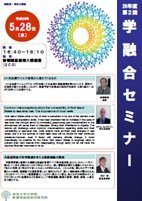AY2014 2nd Gakuyugo Seminar
- Date&Time:
- May 28, 2014 16:40~18:10
- Venue:
- Large Lecture Room (2C0), New Frontier Science Bldg.

What Human Leukemia Virus Research Reveals
Professor Toshiki Watanabe
Research to clarify the pathogenesis of leukemia caused by the human leukemia virus HTLV-1 has led to new insights in biology, and the investigation of ways to prevent and treat the disease has expanded to include social initiatives.

Common misconceptions about the vulnerability of Atoll Island States to sea level rise: The importance of coral reefs
Project Associate Professor Miguel Esteban
Atoll Island States exist on top of what is perceived to be one of the planet's most vulnerable ecosystems: atolls. It has been predicted that an increase in the pace of sea level rise brought about by increasing greenhouse gas concentrations in the atmosphere will cause them to disappear, forcing their inhabitants to migrate. The lecture will challange some common misconceptions regarding atolls and their vulnerability to sea-level rise. Coral islands have survived past changes in sea levels, and it is the survival of coral reefs what will be crucial for their continued existence.However, even if faced with extreme climate change, it could theoretically be possible for the richer Atoll Island States to engineer ways to prevent their main islands from disappearing, though sadly not all will have the required financial resources to do so.

Development of onboard instruments to support scientific observations of lunar and planetary exploration
Visiting Associate Professor Satoshi Tanaka
On the one hand, we want to incorporate "cutting-edge technology" into the equipment used in space probes in order to emphasize performance, but on the other hand, we need to incorporate as much "dead technology" as possible in order to make the equipment highly reliable and robust, since it cannot be touched once it flies. In addition to these, strict constraints are imposed, such as a limited amount of data, limited time, and conditions that are not normally expected in a laboratory. After passing all these requirements, the device is finally ready to leave the lab. Using the seismometer and other instruments that we have developed over the past 20 years as materials, I will introduce the process from conception, development, and installation to the development of the observation instruments.

